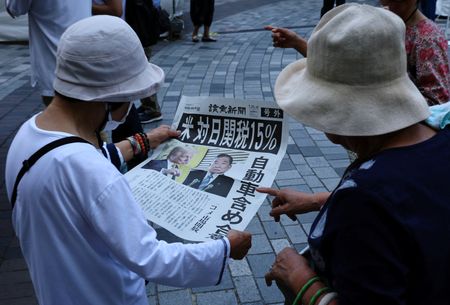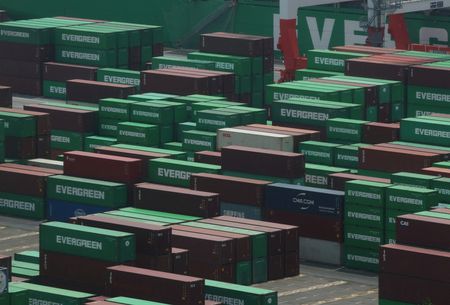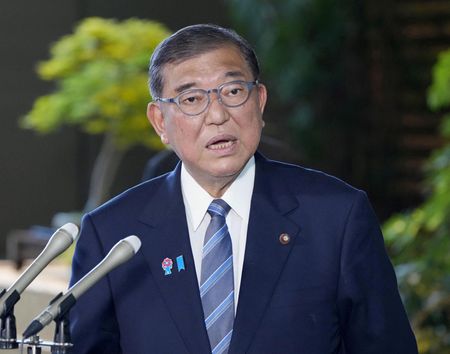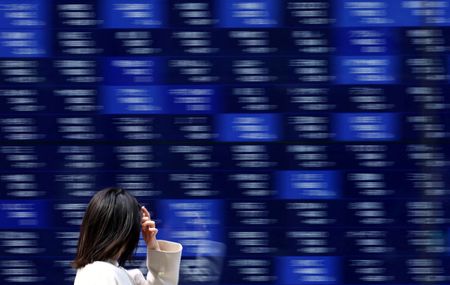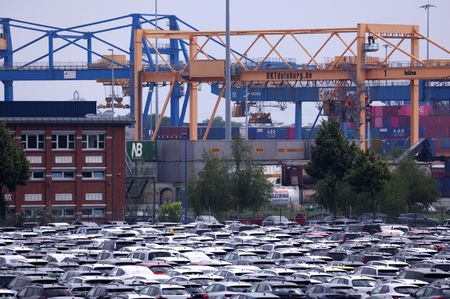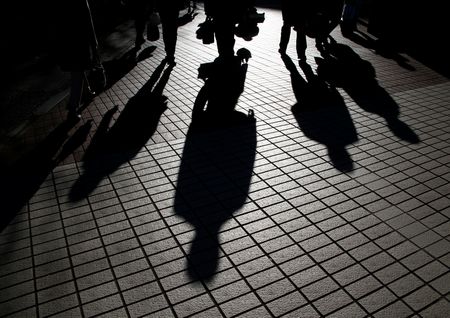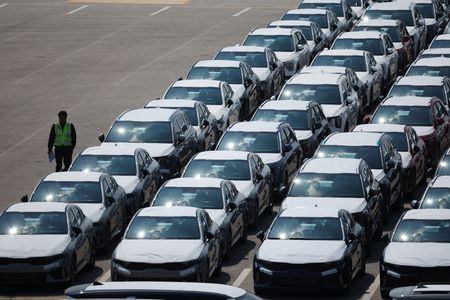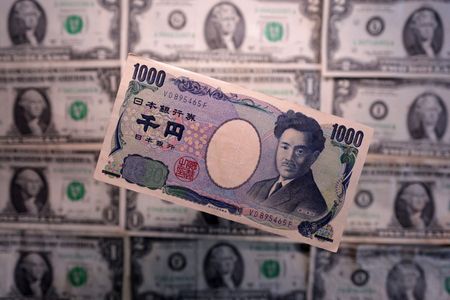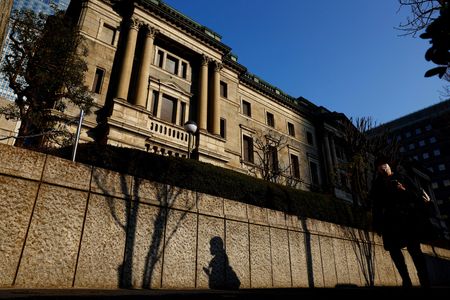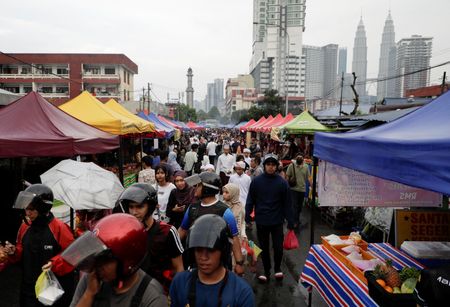By Trevor Hunnicutt and Mariko Katsumura
WASHINGTON/TOKYO (Reuters) -U.S. President Donald Trump struck a trade deal with Japan that lowers tariffs on auto imports and spares Tokyo from punishing new levies on other goods in exchange for a $550 billion package of U.S.-bound investment and loans.
It is the most significant of a clutch of agreements Trump has bagged since unveiling sweeping global levies in April, though like other deals, exact details remained unclear.
Japan’s autos sector, which accounts for more than a quarter of its U.S. exports, will see existing tariffs cut to 15% from levies totalling 27.5% previously. Duties that were due to come into effect on other Japanese goods from August 1 will also be cut to 15%.
The announcement sent Japan’s benchmark Nikkei stock index climbing almost 4% to its highest in a year, led by stocks in automakers with Toyota up more than 14% and Honda nearly 11%.
“I just signed the largest TRADE DEAL in history with Japan,” Trump said on his Truth Social platform. “This is a very exciting time for the United States of America, and especially for the fact that we will continue to always have a great relationship with the Country of Japan,” he added.
Ishiba, who plans to resign after a bruising election defeat on Sunday, according to a source close to the embattled premier, hailed the tariff agreement as “the lowest rate ever applied among countries that have a trade surplus with the U.S.”
The 68-year old leader later said that reports that he had decided to resign were “completely unfounded”.
Two-way trade between the two countries reached nearly $230 billion in 2024, with Japan running a trade surplus of nearly $70 billion. Japan is the fifth-largest U.S. trading partner in goods, U.S. Census Bureau data show.
The U.S. investment package includes loans and guarantees from Japanese government-affiliated institutions of up to $550 billion to enable Japanese firms “to build resilient supply chains in key sectors like pharmaceuticals and semiconductors,” Ishiba said.
Japan will also increase purchases of agricultural products such as U.S. rice, a Trump administration official said. Ishiba said the share of U.S. rice imports may increase under its existing framework but that the agreement did “not sacrifice” Japanese agriculture.
Bank of Japan Deputy Governor Shinichi Uchida called the deal “very big progress” and said it reduces uncertainty over the economic outlook.
Some economists had forecast the tariffs could have tipped Japan – the world’s fourth largest economy – into recession.
The exuberance in financial markets spread to shares of South Korean carmakers, as the Japan deal stoked optimism that South Korea could strike a comparable deal. The yen firmed slightly against the dollar, while European auto shares and U.S. equity index futures rose.
But U.S. automakers signaled their unhappiness with the deal, raising concerns about a trade regime that cuts tariffs on auto imports from Japan while leaving tariffs on imports from their plants and suppliers in Canada and Mexico at 25%.
“Any deal that charges a lower tariff for Japanese imports with virtually no U.S. content than the tariff imposed on North American-built vehicles with high U.S. content is a bad deal for U.S. industry and U.S. auto workers,” said Matt Blunt, who heads the American Automotive Policy Council which represents General Motors Ford and Chrysler parent Stellantis.
‘MISSION COMPLETE’
Autos are a huge part of U.S.-Japan trade, but almost all of it is one-way to the U.S. from Japan, a fact that has long irked Trump. In 2024, the U.S. imported more than $55 billion of vehicles and automotive parts while just over $2 billion were sold into the Japanese market from the U.S.
Japanese Finance Minister Katsunobu Kato told reporters the agreement made no mention of foreign exchange rates, another issue the Trump administration had long complained about.
Trump’s announcement followed a meeting with Japan’s top tariff negotiator, Ryosei Akazawa, at the White House on Tuesday.
“#Mission Complete,” Akazawa wrote on X, later saying the deal did not include Japanese exports of steel and aluminum that are subject to a 50% tariff, nor any agreement on defence budgets.
Japan will also drop additional safety tests currently imposed on imported U.S. cars and trucks – requirements that Trump and other U.S. officials have said limit the volume of American-built vehicles sold in the country.
A photo of Akazawa’s meeting with Trump at the White House indicated the two sides engaged in some last minute negotiations over the investment package to seal the deal.
The photo posted on X by Trump’s assistant Dan Scavino, showed the president seated across from Akazawa with a document titled ‘Japan Invest America’ and a sum of “$400B”. The figure was scored out, with “$500” hand-written above it.
Japan is the largest investor in the United States. Together with pension giant GPIF and Japanese insurers, the country has about $2 trillion invested in U.S. markets.
Besides that, Bank of Japan data shows direct Japanese investment in the United States was $1.2 trillion at the end of 2024, and Japanese direct investment flows amounted to $137 billion in North America last year.
Speaking later at the White House, Trump also expressed fresh optimism that Japan would form a joint venture with Washington to support a gas pipeline in Alaska long sought by his administration.
Trump aides are feverishly working to close trade deals ahead of an August 1 deadline that Trump has repeatedly pushed back under pressure from markets and intense lobbying by industry. By that date, countries are set to face steep new tariffs beyond those Trump has already imposed since taking office in January.
Trump has announced framework agreements with Britain, Vietnam, Indonesia and paused a tit-for-tat tariff battle with China, though details are still to be worked out with all of those countries.
At the White House, Trump said negotiators from the European Union would be in Washington on Wednesday.
(Reporting by Trevor Hunnicutt, Jasper Ward and Mariko Katsumura. Additional reporting by Makiko Yamazaki, Satoshi Sugiyama, Andrea Shalal, David Shepardson, Vidya Ranganathan and Kevin Buckland; Writing by James Oliphant and John Geddie; Editing by Lincoln Feast.)

